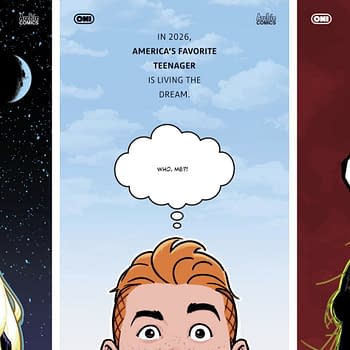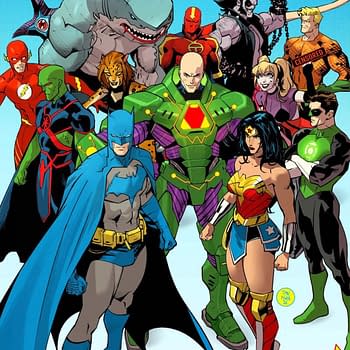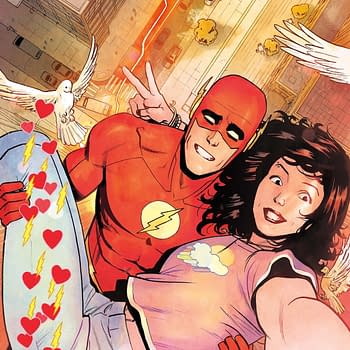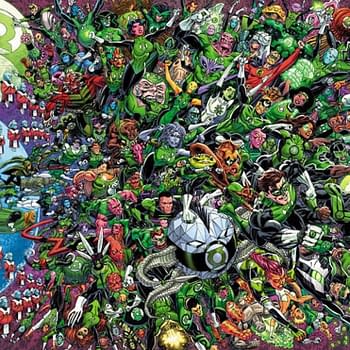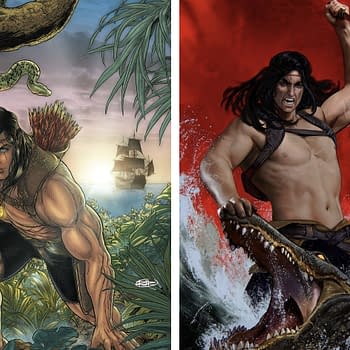Posted in: Comics, Recent Updates | Tagged: Comics, expo, image, richard starkings
Richard Starkings And Bryan Glass Talk To Ryan King

Ryan King: Thank you for taking time out of your busy schedule today to speak with us at Bleeding Cool. It really is an honor meeting the writer behind Image Comic's hit series Hip Flask and Elephantmen and the creator of the revolutionary digital font and design company Comicraft, which also happens to share a 20th anniversary this year. Congratulations!
Richard Starkings: Yes, it does. Thank you.
RK: From what I understand, the originality behind Elephantmen comes from your clever hybridization of science-fiction and pulp-fiction, much similar to the works of Philip K. Dick and the early comics of 2000AD. Is that a strong assessment?
RS: Uh, yeah.
RK: As your series continues, how do you devise keeping your story constantly exciting now that most readers are familiar with the likes of hulking bi-pedal Hippos, Rhinos, and Crocodiles? How much left is there to discover about this futuristic earth, Mappo, and the Elephantmen?
RS: Wow, that's a loaded questions. Gosh, how to answer that one? You know, I think actually it becomes easier to write a book now that the world is pretty nailed down. It's a huge broad canvas that I've created with the various artists that worked on Elephantmen and all I need to do now is study the character's relationship and where those relationships take the characters. So there's lots of story threads that have been sitting very quietly, waiting to be developed. In fact, in the next issue there is a story thread that has taken me thirty-nine issues to get to, which is an Elephantman mission to Mars. That happened like ten years ago, which has always been in the back of my mind and has always been in the subtext but it's only next issue that now I can show a fragment of that story, and people will go like, 'Huh? What? What?' But I knew that was one of the places I wanted to go, I wanted to have the Elephantmen on Mars. Not just because of how the stories have been, but it would really look cool. In fact Axel [Medellin], when I told him—he's the regular artist in the series now—he said, 'Ah, I can't wait to draw Mars.' And that's one of the things that's exciting about the series is finding exciting things for the artist to draw and exciting situations to put the characters in. The story that we've just been telling, 'The Killing Season,' which is issues thirty-six through thirty-nine is the culmination of so many apparently disparate story threads, that it came almost effortlessly together. It's really satisfying to be forty issues in and have to deliver that sort of closure on a character arc or a closure on lots of little threads that we've tied together and while at the same time they start new consequences. Because the truth is when you start any story, this is why soap operas can run forever because characters once they take one action, there is a reaction. A consequence. One of my favorite tv series is Dexter and one thing I like about Dexter is that there is no plot thread left untied. And having said that, when they tie it, it creates another plot thread. So it is really a story of the study of actions and consequences. Every character's action leads to another situation. I think it's actually easier because you'll create a character to fulfill a function on the other character and then that other character has a life and then you can follow that in that direction. I think it becomes easier, not harder. I don't think it's a matter of readers becoming familiar. It's about surprising readers. There is a suspense in that readers always know more about the characters than the other characters do and then there's always a surprise that [I] know more than the readers do.
RK: Would you say there is a redeeming scientific quality about the series? Have you ever put actual scientific thought into the splicing of human and animal DNA or are you more the kind of man who prefers the whimsy of an imagination run amok?
RS: Both. But I did do a lot of research about what was going on in the field of hybridization. They had crossed a rhesus monkey with a jelly fish. They literally created a monkey that glowed in the dark. True story—look it up! They resurrected an extinct species of cow called a guar by impregnating a cow egg with guar DNA that they preserved and they successfully birthed a guar calf, which died within a year I think. But there is a lot of hybridization out there already. I also am fortunate in the production company Zucker Productions that optioned Elephantmen for a major motion picture development, they are also involved. Janet and Jerry Zucker founded The Science & Entertainment Exchange, which is an organization that brings together scientists and entertainers and often at the entertainer's request to find out more about, for instance bio-terrorism. We went to the NASA jet propulsion lab two weeks ago. And basically it's a lot of producers, writers, directors who have an interest in the subject. Michael Mann was there at NASA two weeks ago and Gail Katz who produced Air Force One. It's an opportunity for us to learn about real missions to Mars, so we were in the Mars Mission Control at NASA in Pasadena two weeks ago and that was actually what triggered my Mars storyline. I was like, 'Oh, yeah! We are putting landers on Mars all the time. I've really got to follow up that story thread that I want to do. So one of the things I did was I went to a presentation about optogenetics, which is programming animals to behave a certain way, and they showed footage—which actually some of it is online—of radio controlled beetles that they can cause a live beetle to fly. They put a control device at the pupa stage and they can control the beetle in flight and they can just stop it. They can just flick a switch and then an electric current goes through the brain of the beetle and it just drops out of the sky and the beetle has no override. It's actually controlled. And they've done experiments with mice and rodents to control them. So there's an element of that in Elephantmen because the Elephantmen are actually controlled by a device on the top of the spine. So yes is the answer. I've done a lot of research but I also think that once you start creating a story about certain characters and you look at the hippo and the way the hippo behaves, you look at an elephant and the kind of the emotions Elephantmen excites in people, then you make story choices based on that, which can be emotional or it can be scientific and often your emotional choice will be just as accurate as your scientific. Because you are responding to something more mystic than scientific, because we sort of intuit the way an elephant behaves, we intuit the way a rhino behaves. And sometimes we're projecting human qualities onto those animals so you may as well project those qualities that people expect. You expect a certain tragedy about an elephant, you expect aggression from a rhino. Even if it's not necessarily true that rhinos are aggressive which they're not. They're actually kind of stupid and short sighted and overreact but, you know, the image is a rhino charging after a jeep on safari but they're not. They run away. I think the answer to your question is both because you have to sort of play to people's expectations and deliver plausible scientific explanations something that's currently implausible.

RS: Sure [laughs].
RK: One thing I tend to notice while reading Elephantmen is the usage of great, big, blocky panels? Is there a purpose for this or is it reminiscent of your writing technique?
RS: No, I think a book like Elephantmen has to be big. And, in fact, all our collections are an inch thick because of that, because I feel like the presence of a book called Elephantmen it can't be a thin three millimeter paperback with four issues in it. Also, the concept, you know? When you have a big concept like Elephantmen and you have big scientific insulations and you have big battles and you have big characters, and often times I'll make sure that each character is introduced on a splash page because they deserve it, because they're big characters. In the same way that you'll see the Hulk on a cover or on a splash page, or the Thing, but human characters take up less space. I also wanted on the covers of each of the volumes to have one of the Elephantmen and one of the female characters to give that sense of this is about great big, super-muscular, male human- animal hybrids and super feminine girls and their relationships between them. So it's really about the relationship and not about the weapons Elephantmen coming at you. And I really should reflex that. We have a lot of female readers and a lot of male readers because women respond to the relationship angle and men respond to the horribly good weapon Elephantman coming at you, which it also has.
RK: Do you think we'll ever see an Elephantwoman?
RS: No. I can tell you we won't. Because if you don't have to hybridize females, why would you? If you could eliminate the matter of sexual attraction to another human-animal hybrid, you would. That's the choice you'd make.
RK: Out of strange curiosity, have you ever had someone from the furry community make any comments about your work?
RS: Not really. I mean we were up for—the 'Captain Stoneheart' was up for a—some kind of award from the furry community. I think we do brush up against that line but it's not that—you know furries to me started with a kind of Elfquest depiction of fantasy characters that had real lives including a sex life and I think that the furry community has been isolated down to the sex life. So, I think it's a shame because really that shows an obsession with a slightly strange, amongst people that are judging that community. I think I saw online last year that somebody posted on craigslist that they were coming to San Diego and wanted to hook up with somebody that was into Star Wars so it's going on in every community and I bet the steampunk community has that aspect to it too. It's just something that we sort of look askance upon when it's got ears and a tail.
RK: Moving on. What can you tell me about the future of Comicraft? We're currently in the second hour of the digital age, after twenty years in the industry, do you still feel your company is adequate to deal and perform in today's standards?
RS: We established the standards. So if we raise them, we can meet them. I do think that digital lettering is kind of taken for granted now. And that's okay, because pen lettering is taken for granted. But I think generally across the board that standard of lettering is higher because we have made something like two-hundred and fifty font families. [John 'JG' Roshell] is the creator of most of them, he is the sort of font-meister. He makes all the fonts and that library is available. And when we started out we were working with maybe four or five fonts that we created and our range of expression was greatly limited but I think for the last ten years now we've done a new font every month. So in ten years, we did a hundred and twenty fonts. So people start digital lettering now have access to our library at which they can buy at rock bottom prices. You know? I mean the amount of money we invested into developing them is much greater than what people can buy them for and we're still the leader in digital comic book fonts. We have the largest catalogue and people still come to us at shows all the time and thank us for creating digital fonts that allowed their books to look more professional.
RK: What motivates you to continue in your pursuit of digital design with Comicraft? Is it a hobby or is it more of an obsession?
RS: A hobby? You mean we don't make any money? JG, you answer that one.
John 'JG' Roshell: It pays the bills.
RS: But it's also fun. When you've done over two-hundred and fifty comic book fonts coming up with another one is—amazing! [laughs]
JG: Well, it's fun to be able to switch gears too and design something one day and you know, publishing the next. It keeps things fresh.
RS: And actually Todd McFarlane is asking us, JG doesn't know this yet, but [Farlane] wants a redesign on the font for Haunt because the style of the book has changed. And I actually welcome that because sometimes we are sort of like, 'Well, what do we do next?' We're sort of stuck for ideas and—
JG: Yeah, when there's some sort of demand or need it helps.
RS: Yeah, we need to meet a demand. We need—Troy Peteri who letters for Top Cow was asking—there he is. He's standing right over there. He said he wanted to speak with JG about journal style font and I said, 'Well, this is great because if you have something specific in mind we can design it and then you can buy a copy and we can sell it to a hundred other people.' I actually sort of envy the situation we're in now where I was thirty years ago, because thirty years ago I was limited by what I could do by hand. And now people have this incredible range of choices for style of the book. And you're not stuck with the hand letterer you have access to or can afford. So we're constantly pushing the envelope, we're constantly raising the bar. So we have to meet our own expectations. I think that's true of anything. That's true of Elephantmen. I have to keep pushing myself, I have to write better stories, more compelling characters to satisfy an audience that didn't exist six years ago. And now they do exist and have expectations of me that I'm like, 'Wait, you didn't have an expectation of me six years ago. You know? How can you be wondering about this character? You didn't know this character? But that's what's gratifying about working in comics. People become emotionally attached to characters that you have breathed life into and you've gone through struggle whether that's characters in an alphabet—digital lettering—or characters in a comic book, you have invested time and energy into the creative process people enjoy it when they respond emotionally to your creative process. Every writer in this room, every Image Comics creator goes through an emotional process to put that on the page. Whether it's more thorough or not is the material. They go through a process and put it on the page and readers respond to it.
RK: Is there anything new and exciting this year coming from the team at Comicraft?
RS: Every issue of Elephantmen is going to as exciting. Volume five, which will collect the last story arc from Man and Elephantman issues 31, 32, 33, 36 through 39 and 41 comes out this summer. I'm looking forward to wrapping that up. Tony Parker who illustrated Do Androids Dream of Electric Sheep for IDW, we became friends in the process of working on that book together and he illustrated issue forty. Dave Hine, who did Bullet Proof Coffin and Bullet Proof Coffin: Dissentered for Image has written and drawn issue forty-one. And we have some other surprise artists and cover artists coming out that will just blow you away. Jenny Frison has done two or three covers she's doing for me of the female characters in Elephantmen. Camilla d'Errico has done a second cover for us; it's a beautiful image of Sahara. A new artist called Fiona Ming has done a cover illustration of Ebony and Vanity and there's more, more, more in the works. Dave Sim has done a cover. Took him two years to fit it into his schedule, or it took him two years to fit it, but he completed it two weeks ago and that will be coming out soon.
RK: Thank you again for your time here today. As long as you continue to help create Elephantmen, I can guarantee you me and many other readers will continue reading them.
RS: Cheers!
Ryan King: Bryan J. L. Glass is here, the co-creator of The Mice Templar. You've been with Image for a long while. Where are you going with the series?
Bryan J. L. Glass: We're debuting at this show, Image Expo the climactic issue of volume three. So of the next step of course is to compile volume three into our next trade collection and in the fall we're starting volume four, which is the climactic volume of the saga we began way back in '07 with the first issue.
RK: One thing that strikes me the most looking at this comic is the art obviously. I think it so stands out. It almost reminds me of Mignola right away but it's distinctly different more because the colors that are used. What brought you to the artist on the project?
BJLG: Well, in this case the preliminary artist was my co-creator Mike Oeming who has always cited Mike Mignola as one of his profound influences. And in fact, in volume one, we have a great quote from Mike Mignola on the back, areal thing of beauty. And [Oeming] paid homage to his influence from Mignola by this rat captain that attacked has a Hellboy gauntlet way back in issue one. So yeah, [Oeming] was definitely influenced by Mike Mignola. [Oeming's] look for the rats and the mice in the series were actually derived going back to the 1980's animated film The Secret of NIMH that Don Bluth did based on Mrs. Frisby and the Rats of NIMH. The influence that I bring to the series as a writer is from Watership Down, Richard Adams' saga with the rabbits. When we transitioned from volume one to volume two, and even into the current, Mike just had way too much on his plate and he handpicked a Spanish artist Victor Santos and he has picked up flawlessly in the footsteps of Mike and every volume Mike still does one of the two covers. And every volume opens with a flashback of the battle where the Templar fell, where in each volume we learn a little bit more about how that collapse occurred and Mike always does the opening eight to ten pages that reprise that tale. There is a plan in the works that when the series comes to its official end, were making an epilogue one entire issue that Victor will kind of transition back to Mike Oeming so that Mike gets to close out the series.
RK: That's very cool, and very kind of you guys. I'm sure you're familiar with Archaia's series Mouseguard.
BJLG: Oh, sure. It's wonderful!
RK: Are you guys compared to it? How do you guys feel about the two series almost clashing in todays market?
BJLG: Well, when we debuted both series were in development at the exact same time. David beat us to the market place by one year so we emerged in 2007 into a market place where David had already conquered this little niche. From the moment we were solicited we were instantly perceived as, 'Oh, this is—' Well, I was a nobody then but it was the big Mike Oeming coming in to steal. It became a kind of David and Goliath kind of perception in the battle. Since then me and David Petersen get along great and Mike Oeming is terrific friend of David's. My wife and I have done dinner with David and his wife, Julia. So all is well in the 'real world' mice kingdom amongst the creators. And as the series has progressed everyone has been able to see. If you're going to be honest about it, you look at the two books and they're completely different in art style, in storytelling. We kind of believe that if you're a fan of this genre you can learn to appreciate both books. If you decide you like the softer art style—David just does such beautifully lush—I mean his books are these incredible works of art. But if you want more bloodletting or the harsher edge, it's almost like between the two books we have something for everybody, but for the average fan of this type of story—enjoy both!
RK: You mentioned that the series is going to come to a close very soon. What are your plans for after that? Are you going to just ride the coat tails of Mice Templar and just play it safe, nothing else after that? Or do you have something planned?
BJLG: As the fourth volume unfolds, and it will take a while about a year and a half for volume four to come out. It's going to be about twelve to fourteen issues to close out the saga. So at a monthly rate, we will still be doing Mice Templar in 2014. But while that's coming out, the plan is I want to begin to release through Image several more miniseries of a wide variety of genres. I'm more than just the mice guy. I'm more than the mythology guy, the fantasy guy. It's time to unload some supernatural horror and some invading aliens and galactic sagas. And even a couple super hero things in the works as well.
RK: Do you have any idea of what artist you might possible work with in the future or is that too far ahead of us?
BJLG: No, it's actually one of the things I'm doing here at Image Expo this weekend. A lot of the neat stuff goes on afterhours. Everyone congregates in the various bars and restaurants. I'm networking and trying to match up the right artist that I can work with on which of my many projects that they would be interested in and which project, from my perception, would benefit from their art style.
RK: One quick thing just about Image Expo. How do you feel being here today, this entire weekend, and the performances Image has put on so far?
BJLG: Well, right out of the gate, I was around twenty years ago when everyone said this would last six months. This has been the longest six months I have ever seen and that's awesome that we're here today. The show itself is spectacular. This is my first time in Oakland. So there's another show that debuted around here in— Wonder?
RK: WonderCon.
BJLG: WonderCon. I never got to attend WonderCon. I'm an east coast denizen so this has been spectacular. The weather has been great, the city has been great, the Image Expo has been fantastic.
RK: Great! Well excellent! On behalf of Bleeding Cool, I really appreciate it.
BJLG: Thank you very much!
Ryan King is the current editor-in-chief of Go Suck A Comic (www.gosuckacomic.com), where he can be contacted on all matters of insanity in sub-culture. One day, he intends to do his damnedest at writing the first official Big Trouble in Little China comic series.







